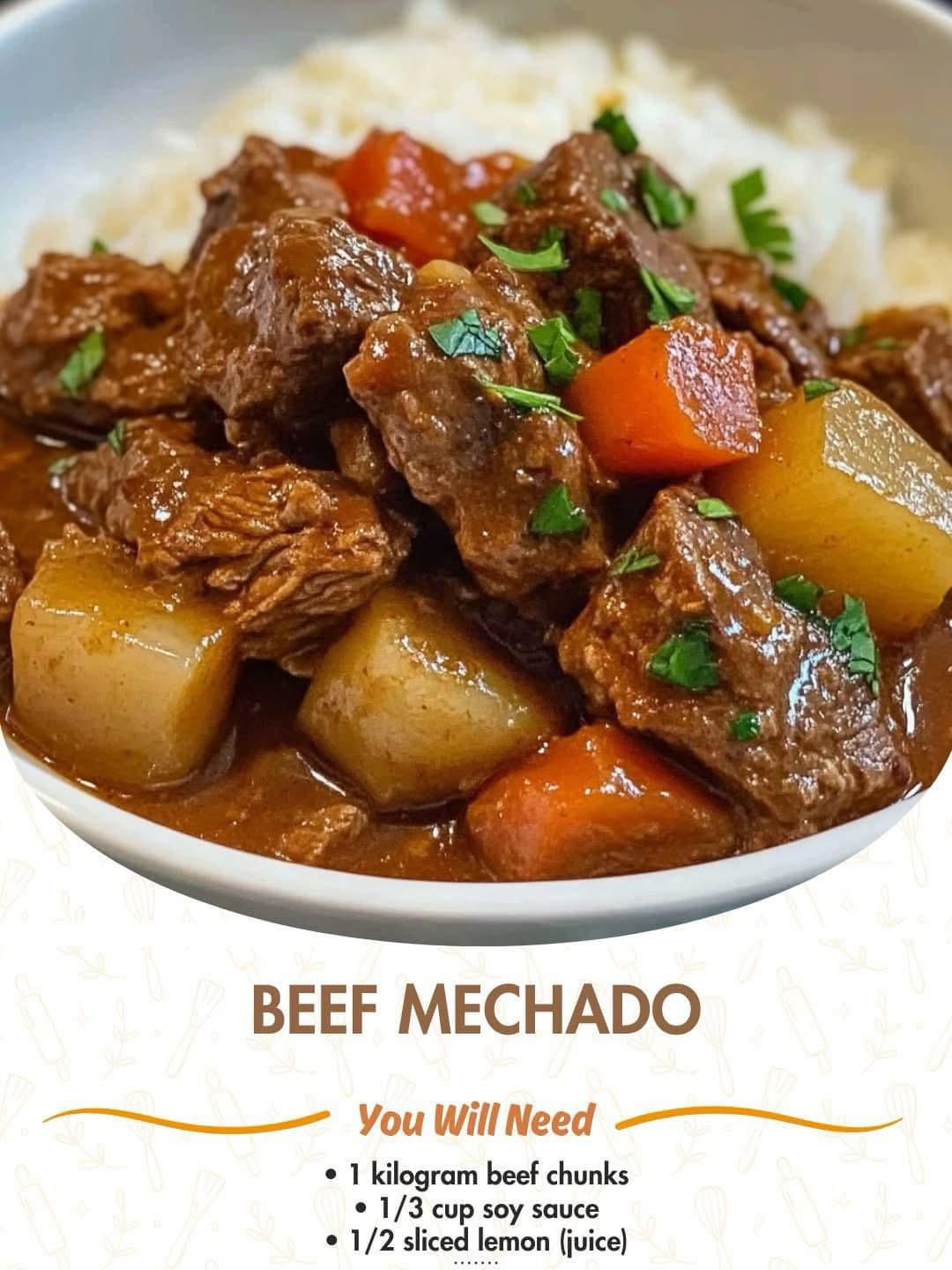ADVERTISEMENT
**Simple Beef Mechado: A Hearty Filipino Classic**
Filipino cuisine is a vibrant celebration of flavors, bringing together influences from its diverse cultural heritage. One dish that stands out as a Filipino family favorite is **Beef Mechado**. This hearty, savory stew is a comfort food in many Filipino households, known for its rich flavor and tender beef. It’s a dish that evokes nostalgia, warmth, and the heart of Filipino home cooking. In this article, we’ll explore everything you need to know about making **Simple Beef Mechado**, from its history and essential ingredients to step-by-step instructions on how to prepare this delicious dish.
### **What is Beef Mechado?**
**Beef Mechado** is a traditional Filipino stew made with beef chunks that are braised in a savory tomato-based sauce. The dish is famous for its tender, melt-in-your-mouth beef and its rich, flavorful sauce. Often served during family gatherings, special occasions, or just a cozy meal at home, Beef Mechado is comfort food at its best.
The dish is also popular in various other Southeast Asian cuisines, with slight variations in how it’s prepared, but the Filipino version has its own distinct flavor profile, marked by a combination of tangy tomato sauce, soy sauce, and the tender beef that falls apart with every bite.
In some recipes, the beef is typically marinated in a combination of soy sauce and calamansi (Filipino lime) juice to help tenderize the meat and infuse it with a deep, savory flavor. One key ingredient that distinguishes Beef Mechado from other beef stews is the addition of **lard** or **pork fat** inserted into the beef before cooking, which infuses the meat with flavor as it cooks.
### **History of Beef Mechado**
The origins of Beef Mechado can be traced back to the Spanish colonization of the Philippines. The Spanish introduced various cooking techniques, including the practice of braising meats in tomato sauce. The name “Mechado” itself is derived from the Spanish word *mecha*, which means “wick” or “string”. This refers to the traditional practice of inserting strips of pork fat into the beef, which resembles a wick. As with many Filipino dishes, **Beef Mechado** evolved to reflect local tastes and available ingredients.
Over time, it became a popular dish in Filipino homes due to its satisfying nature and its ability to feed large families. The combination of beef, tomatoes, and soy sauce is perfect for bringing out deep, savory flavors, while the tender beef makes it a favorite among meat lovers.
### **Ingredients for Simple Beef Mechado**
Creating a perfect Beef Mechado involves balancing a few key ingredients. Below is a list of the essential ingredients that you’ll need to make this comforting dish:
#### **Essential Ingredients:**
1. **Beef Chuck or Brisket** – This cut of beef is ideal for stews and slow cooking. It is full of flavor and becomes very tender when braised for a long time. Some people opt for beef shank, but chuck or brisket are the most common options.
2. **Soy Sauce** – Adds a savory umami flavor and helps tenderize the beef.
3. **Tomatoes** – Fresh tomatoes or canned tomato sauce can be used. They are the base of the stew’s rich, tangy sauce.
4. **Onions** – Sweet onions help balance the tanginess of the tomatoes and provide a mild aromatic flavor.
5. **Garlic** – Adds depth and complexity to the stew, enhancing the overall flavor profile.
6. **Potatoes** – Sliced potatoes are commonly added to Beef Mechado for a filling and starchy component that absorbs the stew’s delicious flavors.
7. **Bay Leaves** – Aromatic bay leaves add a subtle earthy note to the stew.
8. **Pork Fat or Lard (Optional)** – Some traditional recipes call for pork fat to be inserted into the beef. This is an optional ingredient but gives the dish its unique, rich flavor.
9. **Carrots** – Carrots add sweetness and texture to the dish, complementing the savory flavors of the beef.
10. **Salt and Pepper** – Seasoning is crucial to bringing out the full flavor of the dish. Salt and pepper should be added to taste.
11. **Calamansi Juice or Lemon Juice (Optional)** – Calamansi, a small citrus fruit native to the Philippines, is often used in Filipino dishes. If calamansi is unavailable, lemon juice can be used as a substitute.
12. **Cooking Oil** – For sautéing the garlic, onions, and beef.
For Complete Cooking STEPS Please Head On Over To Next Page Or Open button (>) and don’t forget to SHARE with your Facebook friends
